Current Projects and Collaborations
Submarine Groundwater Discharge
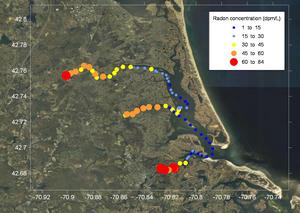 Submarine
groundwater discharge is a flow of fresh groundwater and recirculated
seawater from land into the coastal zone and is recognized as a pathway
of dissolved components from land to the oceans. The dissolved
components often include pollutants from anthropogenic sources, for
example nutrients from sewer systems or agricultural activities on
land. The distribution of these sources along the coastline is not
uniform, and the same is true about the magnitude of groundwater
discharge. Consequently we are confronted with variable non-point
source pollution on the land-ocean interface.
Submarine
groundwater discharge is a flow of fresh groundwater and recirculated
seawater from land into the coastal zone and is recognized as a pathway
of dissolved components from land to the oceans. The dissolved
components often include pollutants from anthropogenic sources, for
example nutrients from sewer systems or agricultural activities on
land. The distribution of these sources along the coastline is not
uniform, and the same is true about the magnitude of groundwater
discharge. Consequently we are confronted with variable non-point
source pollution on the land-ocean interface.
Radon/Nitrate/Methane Mapping in Waquoit Bay and Boston
Harbor, MA.
In order to evaluate submarine groundwater discharge and its role in
non-point source pollution on a large scale (many kilometers of
shoreline) we constructed a radon-methane-nitrate surveying system. The
surveying system is based on measurements of natural constituents of
groundwater: radon and methane in coastal waters. These occur in
groundwater in elevated concentrations in comparison to sea water
therefore can be used as tracers of submarine groundwater discharge.
Areas with high concentrations of radon and methane coupled with high
nitrate values in coastal waters can then be investigated in more
detail to estimate groundwater and nitrate fluxes. The promise of this
technique is that we can map many kilometers of shoreline in a short
time and locate areas with significant submarine groundwater discharge
and non-point source pollution. The projects are funded by the Coastal Ocean Institute at Woods Hole Oceanographic
Institution and the MIT Sea Grant.
 A Multi-Tracer Approach for Estimating Submarine Groundwater
Discharge and Associated Nutrients in Salt Marsh
Estuaries.
A Multi-Tracer Approach for Estimating Submarine Groundwater
Discharge and Associated Nutrients in Salt Marsh
Estuaries.
We explore two different pathways of nutrient delivery via groundwater
discharge in two contrasting New England salt marsh estuaries: in the
first, freshwater is delivered primarily by overland flow; in the
second freshwater input is dominated by groundwater discharge. We used
geochemical tracers, radon- and radium isotopes, to determine
large-scale fresh groundwater discharge. We also quantified tidally
induced pore water circulation through the marsh bank sediments. A
multi-tracer mass balance model was used to evaluate pore water
residence time, which in turn was used to estimate carbon
remineralization rates derived from pore water nitrogen increases over
time. We also examined the role of the spring-neap tidal cycle in pore
water exchange dynamics. The project is funded by the Woods Hole Sea Grant.
Assessment of Groundwater Derived Nutrient
Inputs and Their Implication on the Occurrence of Algal Blooms in
Maui.
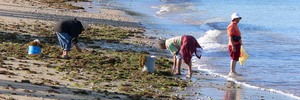 This interdisciplinary project is lead by scientists from the University of Hawaii. I use radon and
radium isotopes as tracers to assess the dynamics and distribution of
submarine groundwater discharge in the coastal zone off Kihei and
Waipuliani parks. The Kihei area is prone to frequent occurrences of
algal blooms. The geochemical tracers revealed significant groundwater
discharge in the area and currently, we are looking into links between
algal blooms and groundwater discharge dynamics.
This interdisciplinary project is lead by scientists from the University of Hawaii. I use radon and
radium isotopes as tracers to assess the dynamics and distribution of
submarine groundwater discharge in the coastal zone off Kihei and
Waipuliani parks. The Kihei area is prone to frequent occurrences of
algal blooms. The geochemical tracers revealed significant groundwater
discharge in the area and currently, we are looking into links between
algal blooms and groundwater discharge dynamics.
Tracing shelf-derived component transport offshore
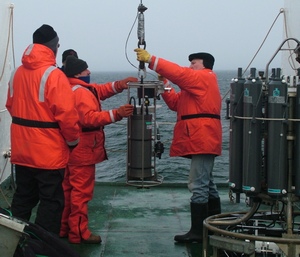 Natural Iron Fertiliztaion in the Southern
Ocean: Investigating Horizontal Iron Transport and Vertical Carbon Flux
Using Radium Isotopes and 234Th.
Natural Iron Fertiliztaion in the Southern
Ocean: Investigating Horizontal Iron Transport and Vertical Carbon Flux
Using Radium Isotopes and 234Th.
There are regions of the high nutrient-low chlorophyll (HNLC) Southern
Ocean that appear to be naturally fertilized by iron sources other than
atmospheric deposition. One such area is the Southern Scotia Sea,
downstream of the Antarctic Peninsula and the Shackleton Fracture Zone
(SFZ). Here, we used radium isotopes as tracers of water transport to
investigate the possibility that shelf-derived Fe is fueling
phytoplankton blooms. We used 224Ra to calculate the rate of
shelf derived iron transport into the HNLC offshore waters where we
calculated the corresponding vertical carbon flux using
234Th.
Sources of Iron to the Eastern Tropical
Atlantic: Does the Continental Margin Supplement Saharan
Dust?
On a cross-shelf transect near Mauritania we will closely examine the
potential lateral source of Fe from the continental margin, and
evaluate it against atmospheric sources of Fe. We will combine
measurements of specific tracers to uniquely determine the importance
of lateral transport vs. dust inputs and subsurface remineralization as
Fe sources to the surface ocean. We will use synchrotron x-ray analysis
of particulate iron “hotspots” and distinguish dust-derived vs.
continental margin iron. At the same time we will derive horizontal
mass transfer rates form 228Ra and vertical transport of
particles and remineralization rates form 234Th profiles.
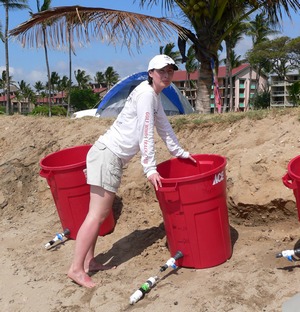 Development of New Radiochemical Methods
Development of New Radiochemical Methods
Determination of 227Ac in Young
Basaltic Samples.
227Ac can be used as a radiometric dating tool and tracer of
melt transport rates and magma storage times.
For this application I developed an extraction chromatographic method
to separate 227Ac from the rock matrix. The actinium values will be used by Ken Sims (WHOI
G&G) in combination with 231Pa as a chronometer for
dating of young mid-ocean ridge basalts in the time range of 10-100
years.
High-Sensitivity Method for 228Ra
Determination in Water Samples.
Open ocean 228Ra values are very low and even
pre-concentration of radium on Mn-fibers from 500 Liter samples does
not provide enough activity for gamma-spectrometric determination. We
are working on developing an extraction chromatographic method to
separate radium from the sample matrix and its consequent measurement
directly by beta-counting or via alpha-counting its grand-daughter
228Th.
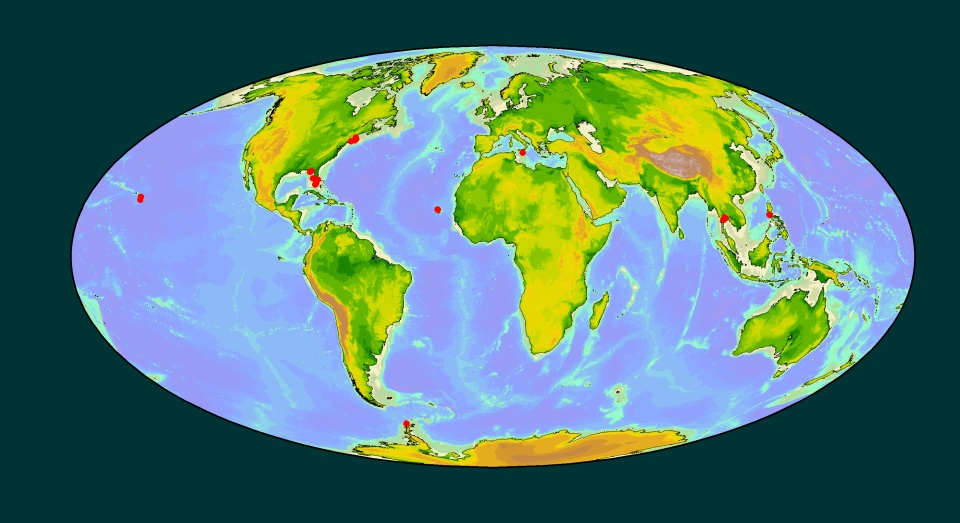
 Submarine
groundwater discharge is a flow of fresh groundwater and recirculated
seawater from land into the coastal zone and is recognized as a pathway
of dissolved components from land to the oceans. The dissolved
components often include pollutants from anthropogenic sources, for
example nutrients from sewer systems or agricultural activities on
land. The distribution of these sources along the coastline is not
uniform, and the same is true about the magnitude of groundwater
discharge. Consequently we are confronted with variable non-point
source pollution on the land-ocean interface.
Submarine
groundwater discharge is a flow of fresh groundwater and recirculated
seawater from land into the coastal zone and is recognized as a pathway
of dissolved components from land to the oceans. The dissolved
components often include pollutants from anthropogenic sources, for
example nutrients from sewer systems or agricultural activities on
land. The distribution of these sources along the coastline is not
uniform, and the same is true about the magnitude of groundwater
discharge. Consequently we are confronted with variable non-point
source pollution on the land-ocean interface.

 This interdisciplinary project is lead by scientists from the
This interdisciplinary project is lead by scientists from the 
 Development of New Radiochemical Methods
Development of New Radiochemical Methods